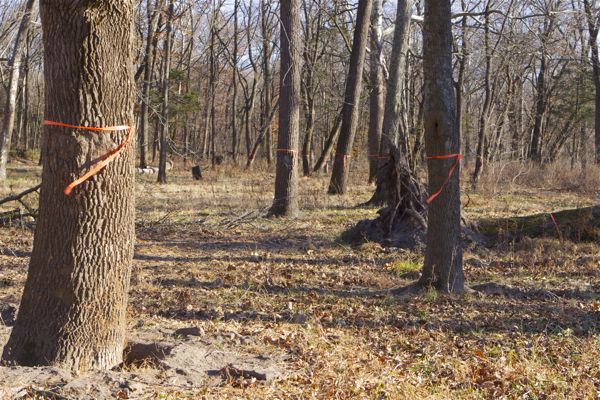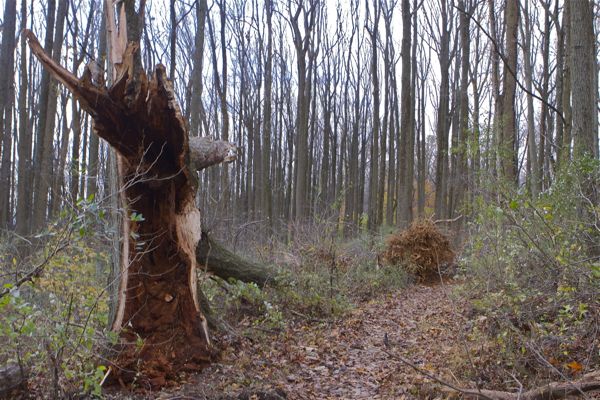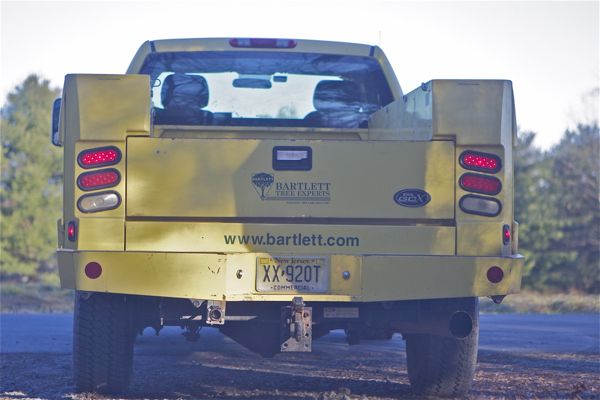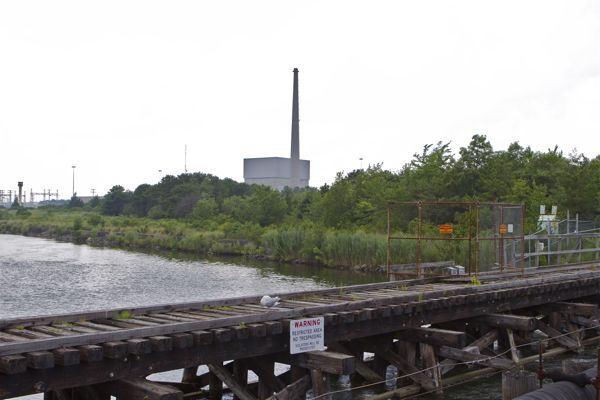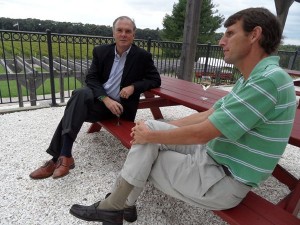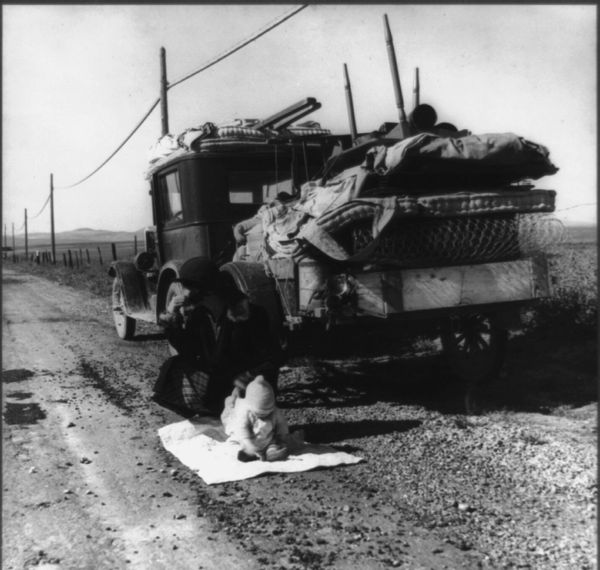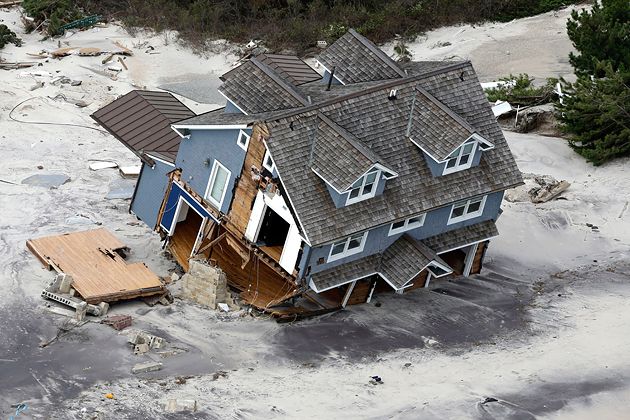Bulls Island and Baldpate Mountain Sandy Storm Update
Little Storm Damage to “Dangerous” Bulls Island Trees
Most Serious Threat to the Forest Remains DEP
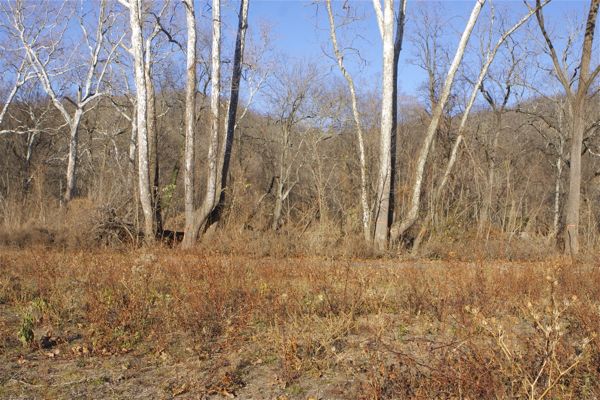
Bulls Island - Central portion of Island. In rear, sycamores are tagged, I suspect for cutting. The invasives in foreground are part of DEP riverfront bulldozing that remains to be restored properly, despite USACE Order.
While most folks were doing their last minute Thanksgiving shopping today, I ducked out to Bulls Island to do a quick storm damage assessment and update.
On November 4, I walked Baldpate Mountain and will report on that as well in this post.
I) Bulls Island
Unfortunately, I missed the last meeting of the D&R Canal Commission on Monday, November 19 – but sent in written comments (see below).
I am pleased to report that, despite near hurricane winds, the 6 acre area of the northern tip of Bulls Island covered by large mature forest and magnificent 200 year old sycamores- the area that DEP claimed was “dangerous” due to trees with rotting roots – suffered little if any damage. I saw no downed trees. None.
As recently as September, DEP claimed:
Ragonese tells me “it’s a matter of the trees being dangerous; the root systems are bad. This incident that occurred brought to our attention an issue we did not know existed. If someone were to walk in the park and get hurt by a tree, I don’t know how we would be able to look them in the eye.” True, two more sycamores have fallen, though in forest area and toward the river. “If we don’t take these trees down now, they’re going to come down and fall,” he says.
If the root systems on those giant sycamores were rotting, one would assume that 60+ mph winds from “Superstorm Sandy” would have knocked them down.
But that didn’t happen. Those trees all held up just fine. This calls into question DEP’s assessment.
While I saw no downed trees in the northern portion, I did see a couple of downed trees in the central portion of the Island – that’s the area DEP recently also assessed and plans to cut even more trees (see below photo).
In the central portion, there were dozens of large healthy looking trees with orange tape around them, and a Bartlett Tree Service Crew was on site with equipment. So I fear cutting could be imminent.
I saw 1 large old oak tree and 1 sycamore down – but the trunk of the sycamore snapped about 6 feet up, so the roots held up just fine.
II) Baldpate Mountain
I walked Baldpate on November 4.
While I didn’t see the entire forest, the good news is that the large majority of the towering tulips did just fine.
I did see about 20 downed trees (more oaks than anything else), but most were either diseased or knocked down like bowling pins as 1 large tree fell and took out others it hit as it fell.
III) D&R Canal Commission Update
The D&R Canal Commission is exploring whether to update and amend the park Master Plan.
Gov. Christie has proposed to replace the entire Commission. That would not only be a huge loss of institutional knowledge and experience, but it would compromise the independence and integrity of the Commission.
I couldn’t make the meeting so I submitted written comments:
Dear Director Dooley – I am unable to attend today’s meeting but would like to provide the following input to the Commissioners:
1. Please thank DEP Parks for the maintenance work along the trail just north of Bordentown. I appreciate the responsiveness.
2. I would like to reiterate my prior points on the Master Plan:
“I then rose to object and advise that the DAG failed to mention important planning powers to amend the Master Plan (“or portion thereof“) in lieu of a comprehensive update. This would enable a targeted planning effort on the future of Bull’s Island.
Here the applicable satutory language, in boldface:
13:13A-13. Master plan for physical development of park; review of State projects, permits.
13. a. The commission shall prepare, or cause to be prepared, and, after a public hearing, or public hearings, and pursuant to the provisions provided for in subsection 13 b. of this act, adopt a master plan or portion thereof for the physical development of the park, which plan may include proposals for various stages in the future development of the park, oramend the master plan.
As I wrote:
“The current D&R Canal State Park Master Plan is 23 years old, last updated and adopted in May 1989. The Master Plan provides an excellent historical overview, assessment of current conditions, and a vision for the Park’s future. The Plan explains the roles and responsibilities of the various agencies with involvement in the Park, and provides a resource inventory of the Park.
The Vision, principles, and objective adopted by the Plan (p. 31) are particularly important and relevant.
The Plan emphasizes the unique nature of a linear park. The Plan recognizes that despite the multi-uses of the Park, there is a special need for “serenity and separation from the man-made world”. To assure that serenity, the Plan explicitly rejects compromising the protection of designated uses by competing uses.
The principles and strong sense of separation from man-made activities in the rural portions of the Park are core values. Of particular relevance to Bull’s Island debate is this principle:
“To the extent that it is practical, the Canal Park is an area that should be maintained in its natural state. […]”
We welcome a planning process that focuses on maintaining Bull’s Island in its natural state.
I urged the Commissioners to engage a planning process for Bull’s Island BEFORE departing “into that good night”.
The policy issue could be framed and planning methods defined for the next Commission. The policy issue would be whether to designate the northern tip as a Natural Area, as the southern portion of the Island currently is designated. The planning methods would focus on forest ecology and natural characteristics, including the tip of the Island’s importance in maintaining the structural integrity of the Canal as a water supply source.
I praised the current Master Plan, particularly the enlightened principle that “the park must retain a degree of serenity and separation from the man-made world” and the overall approach of the plan to advancing the various principles and objectives.
Typically, planners must weigh and balance competing or conflicting objectives. The Canal Master Plan is unusual in how it explicitly rejects this balancing framework in principle.
Principle: As a multi-use resource, each of the Canal Park’s primary roles must be given equal weight.
The different roles of the canal – as a water supply system, a recreational site, history site, natural area, and means of enhancing urban areas – are not to be ranked in importance so that compromises can be made. Compromises do not have to be made at all; accommodation of equal importance of each use is the guide. (@ p.32 – emphases mine)
I advised the Commisioners that DEP’s proposed plan to cut trees to protect recreational users would compromise other critical Master Plan objectives and uses, including maintaining the Island as a natural area and protecting water supply, a clear violation of a core principle of the Plan which is to reject the notion of ranking and balancing and compromising objectives!
If the Commisioners would initiate a planning process, that would do damage control on the ultimate DEP plan for cutting trees and send a clear expectation and message to the new Commissioners: Don’t Mess With Bull’s Island!
Full post here: Thank you. Bill Wolfe, Director, NJ PEER
I urge readers who live in the area to please stay on top of the Bulls Island situation – because of my recent move to Bordentown, I am unable to get there as often. Don’t let the Bartlett Boys do any cutting!
